All sorts of invaders attack lawn grass, from insects to fungi and weeds. A healthy lawn can decrease the chances of your yard being invaded by common weeds that look like grass.
However, no matter how hard you try to keep your lawn lush and perfectly manicured, you are bound to be attacked by pesky lawn weeds at one stage or the other. In this article, you will learn about common weeds that look like grass.
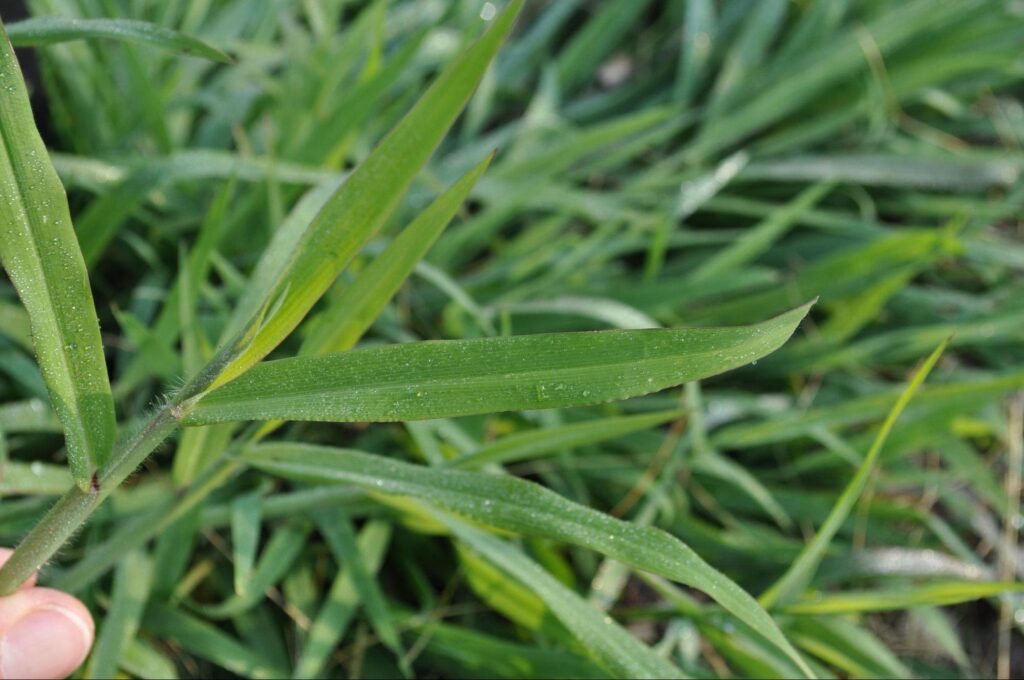
Smooth Crabgrass: A weed grass and an invasive weed.
Weeds come in all sizes, shapes and colors, and let’s be honest, they are not welcomed. However, when you get attacked by weeds that look like grass, you will not even know where they are on your vibrant, thick lawn.
Weeds that look like grass can hide in plain sight and are often easily overlooked if you don’t know what you are looking for.
An invasion of grass-like weeds is subtle at first, but these stealthy creatures can become a serious nuisance if not controlled in time.
So, let’s go ahead and look at some of the common weeds that look like grass and how you can identify them. We will also discuss some of the most effective weed control methods along the way. Happy Reading!
Common Weeds That Look Like Grass
Nature is a clever mistress, sometimes tricking even the most brilliant lawn owners. It can disguise some of the most invasive species of weeds in the form of lawn grass.
Some of these grassy weeds are pretty hard to control and may require the use of specific herbicides. Identifying the weed is the first step if you want to remove a weed and keep your lawn healthy. Here’s a list of some common grass-like weeds and how you can identify them:
Nutsedge
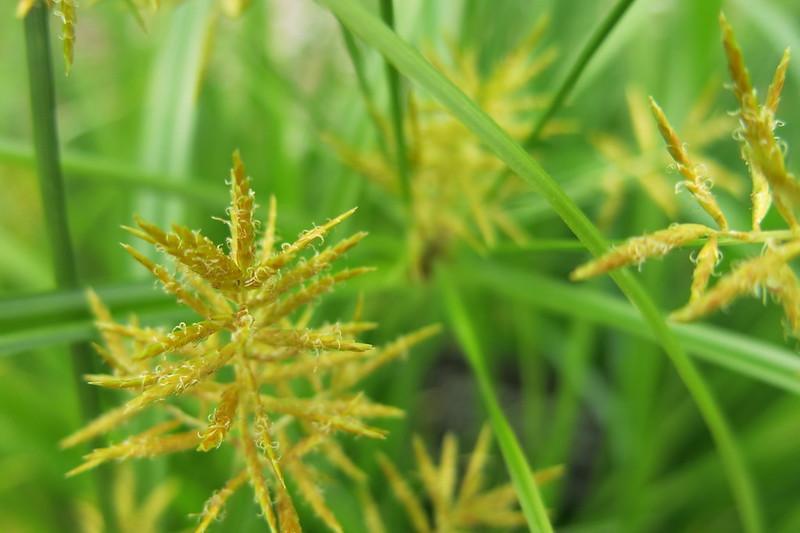 Yellow nutsedge. | 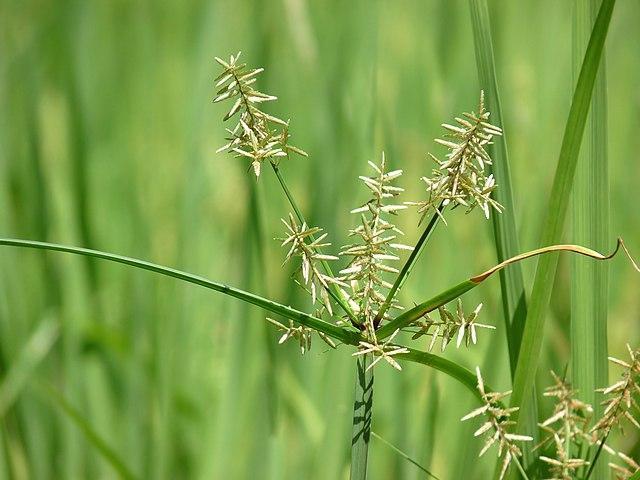 Purple nutsedge. |
There are two species of this perennial weed that often show up uninvited on the lawns: Yellow nutsedge and Purple nutsedge. Before it matures, the nutsedge looks like just tall grass on the lawn.
Both purple and yellow nutsedge have a robust root system that in addition to absorbing water & nutrients, also plays a role in reproduction.
Unfortunately, nutsedge is a prolific spreader too. It spreads via rhizomes and can even jump from your neighbor’s lawn into your home via airborne seeds.
When hand pulling nutsedge from your lawn, remove all the underground rhizomes, or the weed will grow back. Specific pre-emergent herbicides can also be used, but we suggest going organic.
Keep your lawn well-maintained and healthy, and your chances of being invaded by nutsedge will be significantly reduced.
Nutsedge Quick Facts & Identification
| Scientific Name | Cyperus rotundus |
| Other Names | Nut grass, Java grass, Coco grass, Red nutsedge, Purple nutsedge, Yellow nutsedge |
| Weed Type | Perennial |
| Height | up to 140 cm (55 in) |
| Identification | – Flowering stems are triangular in cross-section – Inflorescence is in the form of spikes – Spikes are 3 to 8 in number and unequal – Nut-like tubers on roots – Leaves are creased with prominent mid-veins. |
| Habitat | Grows in moist environments in small patches. Typically present in wet fields, heavily irrigated crops, and ditches |
RELATED: Overseeding A Lawn With Weeds: A Simple And Easy Guide
Green Foxtail
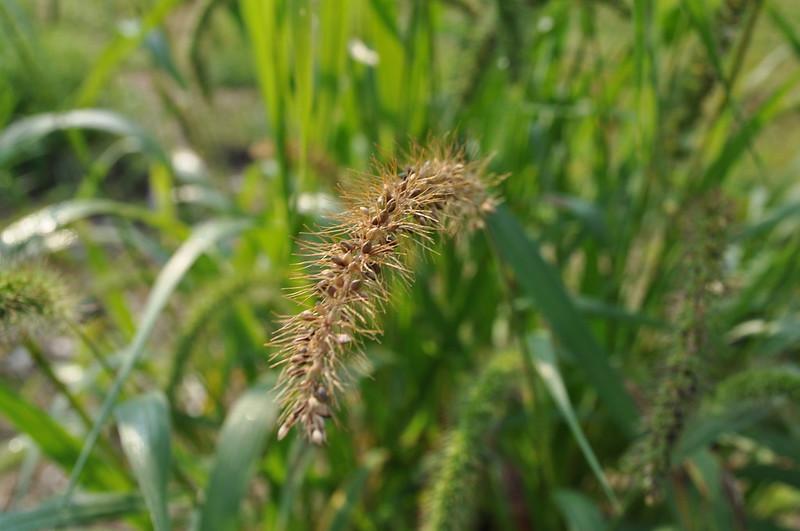 Seedhead of green foxtail. |  Growth habit of green foxtail. |
This grassy weed gets its name from the mature seed heads that look like small fuzzy foxtails. Despite having a cute name, the green foxtail is an invasive species that often invades common lawn grasses and is particularly a problem for farmers. Green foxtail plants are prolific seed producers. A single plant can produce around 34,000 seeds.
However, the good news is that green foxtail is not a very good competitor. It does not grow well in cool and warm soil. That is why it can be easily controlled with a thick lawn.
Increasing soil fertility is another excellent strategy to prevent the spread of green foxtail. All in all, instead of using herbicides, try crowding the weed to compete it out naturally.
Green Foxtail Quick Facts & Identification
| Scientific Name | Setaria viridis |
| Other Names | Wild foxtail millet, Green bristlegrass, Pigon grass, Bottlebrush, Bottle grass, |
| Weed Type | Annual weed |
| Height | 1 to 4 feet |
| Identification | – Leaves have a bright green color and are very sparsely hairy – Leaf-blades are around 12 inches in length – Stems are erect and bent at nodes – Inflorescence is in the form of fuzzy heads |
| Habitat | The weed prefers moist, coarse-textured soils. It is typically found in gardens, lawns, irrigated crops, and along streams, roadsides and waste places. |
Tall Fescue
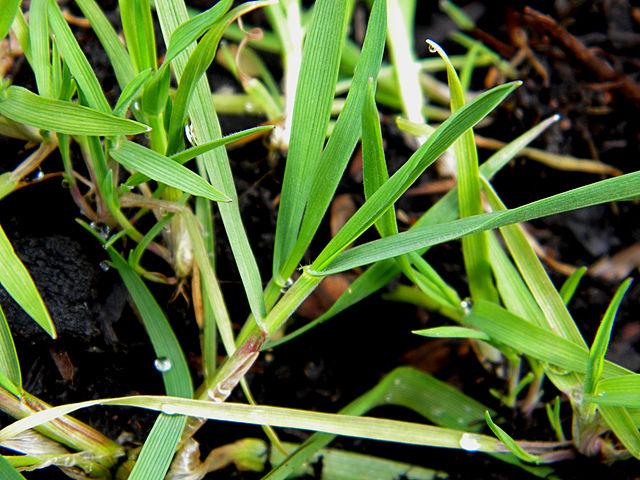 Leaves and stems of tall fescue grass. | 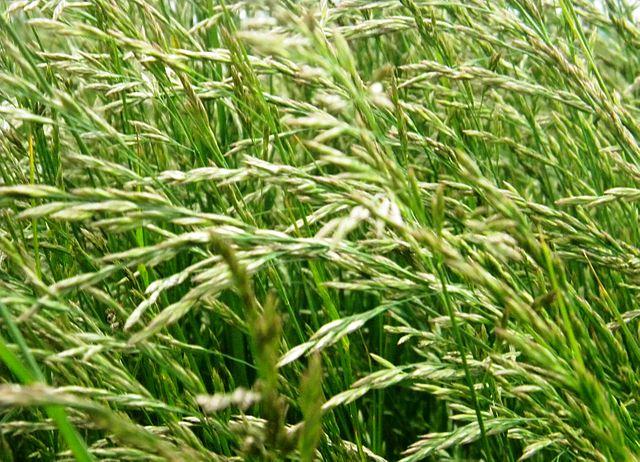 Inflorescence and seeds of tall fescue grass. |
Tall fescue is a severe issue for wildlife and farms. As its name suggests, it is a tall grass that can limit the movement of livestock and wild animals when fully mature.
Birds that feed tall fescue seeds fall sick or die. Tall fescue grows thick and tall, and it can quickly dominate the entire lawn leaving little space for other plants to grow.
Tall fescue is sometimes used in pastures, but when used in lawns with other fescue grasses, it sort of gives a clumpy appearance —as compared to other grassy weeds, spotting tall fescue is relatively easy.
It can be easily spotted in Kentucky bluegrass lawns because of its bunch-type growth habit, which gives rise to clumps.
To control tall fescue from spreading, you can cut them out with a shovel or knife. However, post-emergent herbicides can be used if the infestation has become severe.
Also, to prevent future infestation, you can apply a pre-emergent herbicide before the growing season as well.
Tall Fescue Quick Facts & Identification
| Scientific Name | Festuca arundinacea |
| Other Names | Kentucky 31 fescue |
| Weed Type | Perennial weed |
| Height | 3.5 to 5 inches |
| Identification | – Leaf blades are wide with equal-sized prominent veins – It has panicle-style seed heads – Upper leaf surface is distinctly ridged |
| Habitat | It can grow and tolerate nutrient-poor, acidic, and compacted soils. Often found in pictures, former tall-grass prairie, and abandoned agricultural fields. |
RELATED: What Is The Best Way To Kill Weeds Permanently? A Simple & Easy Guide
Wild Garlic
 A wild garlic field. | 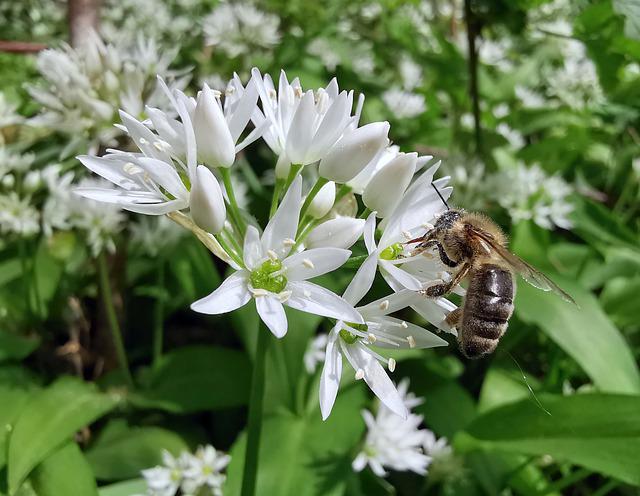 Wild garlic flowers up close. |
In the northeast, wild garlic is the first perennial weed that shows up in late fall or winter. In early spring, its peculiar growth habit gives the lawn a patchy look. Although garlic weed looks like grass, it is not hard to spot because of its characteristic smell.
Wild garlic has a tough root system that allows it to even take hold in thin soils of driveways and rock gardens. Unfortunately, most pre-emergent herbicides are not effective against wild garlic.
To control its spread, you have to rely on a post-emergent herbicide. Wild garlic has to be sprayed more than once and even for multiple seasons.
It is because its leaf has a glossy texture to which most herbicides do not readily adhere. A dense grass lawn can also reduce your chances of wild garlic infestation in the first place.
Wild Garlic Quick Facts & Identification
| Scientific Name | Allium vineale |
| Other Names | Ramson, Broad-leaved garlic, Buckram, Wood garlic, Bear’s garlic, Bear leek |
| Weed Type | Winter perennial |
| Height | 50cm (20 in) |
| Identification | – Leaves are bright green and have a pointed shape – Flowers are white and have a six-point star shape – Strong scent with a garlic aroma – Grows in dense clumps, often carpeting the ground |
| Habitat | The species favors disturbed or chalky soils. Usually found in waste grounds, fields, lawns, thickets, orchards, and cultivated areas. |
Smooth Bromegrass
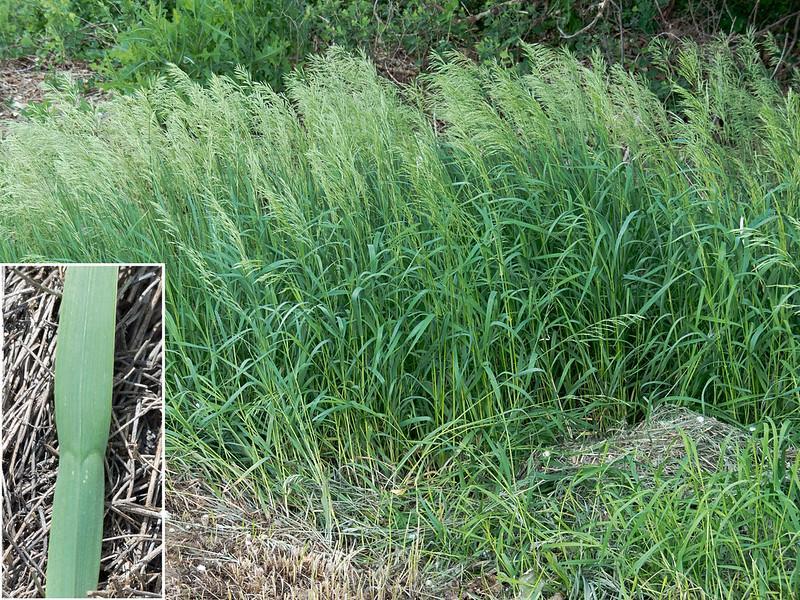 Smooth bromegrass growth habit. |  Smooth bromegrass seeds and flowers. |
Not all weeds are a mere nuisance. Take smooth bromegrass, for example; it can grow rhizomes underground and form a dense root system that firmly holds soil particles together.
A character that makes it able to prevent soil erosion and an excellent ground cover choice. That’s not all; smooth bromegrass also makes excellent forage for livestock animals.
However, smooth bromegrass can often become a problematic weed, especially in wheat fields. Seeds are the most important source of its infestation, and controlling the seed bank is the key to controlling its spread.
A few selective herbicides are available for cereal crops to prevent bromegrass from spreading; however, it has developed resistance to many herbicides over the years.
Smooth Bromegrass Quick Facts & Identification
| Scientific Name | Bromus inermis |
| Other Names | Awnless brome, Smooth brome, Austrian bromegrass, Brome inerme |
| Weed Type | Long-lived perennial |
| Height | Three to four feet |
| Identification | – Leaves are smooth, flat, and have rough margins – A W or M-shaped constriction can be usually found on leaves – Flowers bloom in late summer between June and July |
| Habitat | Grows well in deep, moist, and well-drained soils. Can be found in pastures, prairies, fields, and woodlands. |
RELATED: Garden Weeds With Pink Flowers (And How To Get Rid Of Them?)
Annual Bluegrass
 Annual bluegrass turf. | 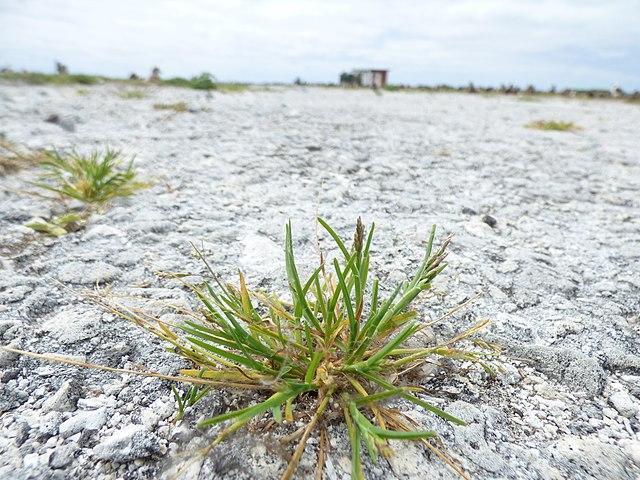 Annual bluegrass on an abandoned runway. |
A cool-season annual plant that grows best in shady areas with moist and compacted soil conditions. Even when mowed at low height, annual bluegrass is still a prolific seed producer.
The most important thing you can do to control its spread is to water your lawn deeply and infrequently. Deep and infrequent watering promotes the development of an extensive root system that will help your grass better compete against these annual weeds.
The core aeration of lawn soil is another cultural method to control annual bluegrass and its spread. Limiting soil moisture near the soil’s surface also reduces the germination rate of annual bluegrass.
Chemical control methods include using pre-emergent herbicide in fall before the seeds of annual bluegrass germinate.
Annual Bluegrass Quick Facts & Identification
| Scientific Name | Poa annua |
| Other Names | Annual meadow grass, Walkgrass |
| Weed Type | Annual |
| Height | 6 to 8 inches |
| Identification | – Leaf blades are yellow-green to dark green – Leaves are often crinkled at the midsection – Leaf tip is somewhat boat-shaped – Produces greenish-white seed heads |
| Habitat | Common weed on golf courses. Colonizes disturbed habitats. Can also be found in lawns, gardens, agricultural fields, and open forests. |
Creeping Bentgrass
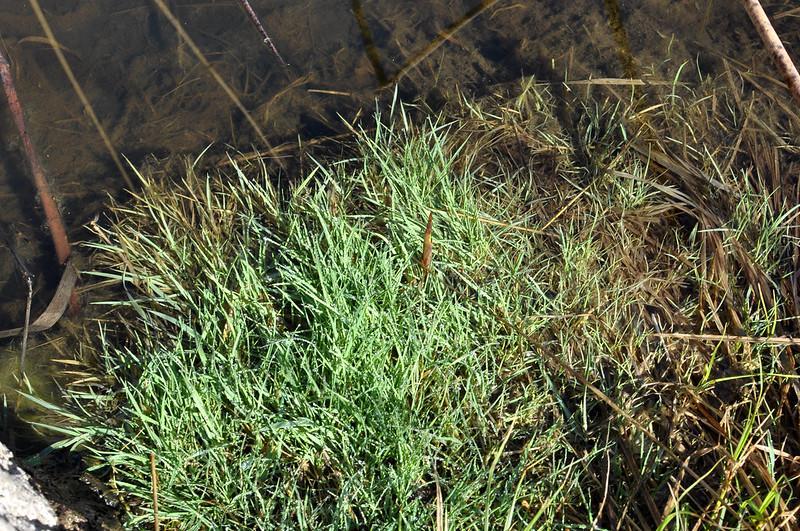 Creeping bentgrass grows in dense clusters. | 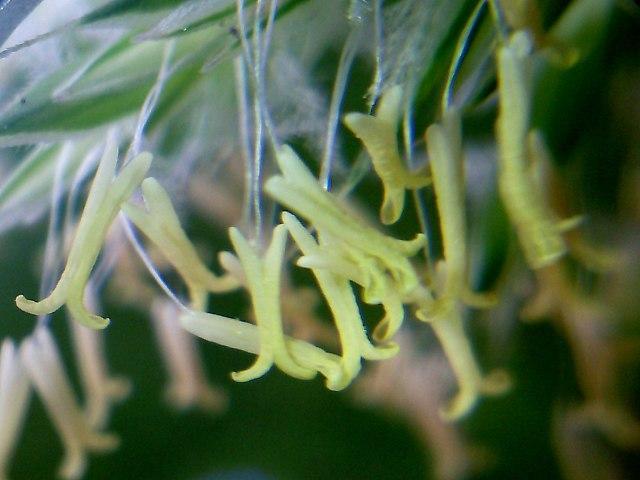 Creeping bentgrass flowers. |
Creeping bentgrass is a popular choice when it comes to putting greens and fairways on tennis lawns and golf courses. It is also the most planted and most popular bentgrass.
However, when present in other grass lawns, it can quickly become weedy and take over entire yards. It spreads very aggressively through its horizontal stems or stolons. It allows the creeping bentgrass to make dense mats that outcompete other native plants or grasses.
Creeping bentgrass is also very frequently confused with Bermuda grass. However, Bermuda is covered with hairs and has coarse stolons. Cultural control is often not effective when it comes to controlling creeping bentgrass.
The entire plant responds very well to most maintenance practices. Gardeners suggest using a plastic sheet to smother and heat kill the creeping bentgrass.
Creeping Bentgrass Quick Facts & Identification
| Scientific Name | Agrostis stolonifera |
| Other Names | Creeping bent, Carpet bentgrass, Fiorin, Spreading bent |
| Weed Type | Perennial |
| Height | 0.125 to 0.5 inch |
| Identification | – The grass has a shallow root system and horizontal growth patterns – Leaves are bright green with a very fine texture – Leaf-blades are often relatively thin – Flowers between June and August |
| Habitat | It is commonly found in damp arable fields, grasslands, and waste grounds. |
Common Couch
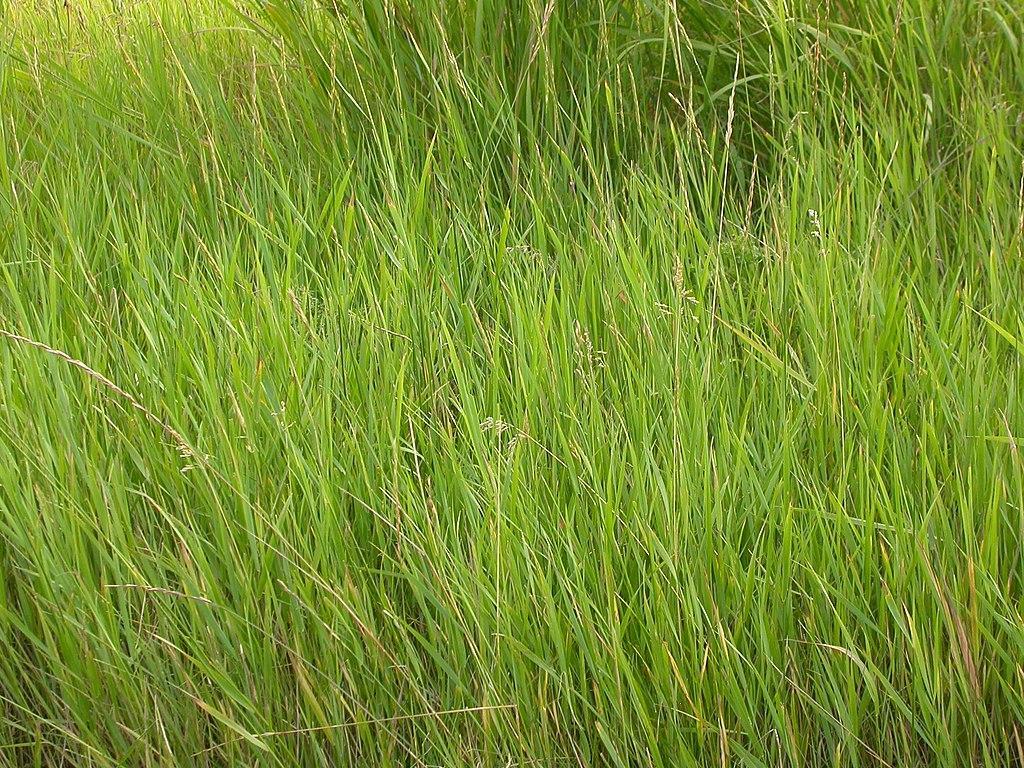 A dense growth of the common couch. | 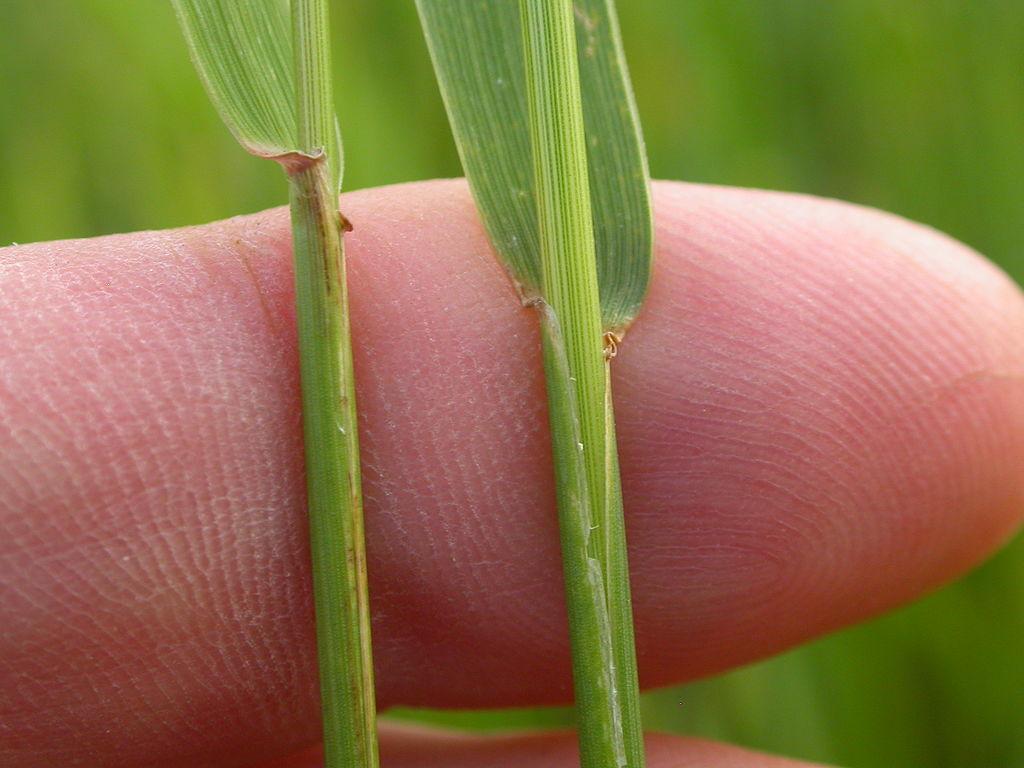 Common couch has finger-like leaves or shows finger-like projections at the leaf base. |
The common couch is an old enemy of many lawn owners and gardeners. Its wiry underground stems and creeping shoots can pop up uninvited around plants on the lawn and spread over the entire garden beds before long.
But, that’s not all; common couch grass can rapidly spread from infested lawns to the neighboring areas via their rhizomes. These rhizomes can easily hide amongst the soil, manure, or roots of other plants.
To control common couch grass, we suggest digging the grass out as much as possible or using mulch to suppress its growth. However, in situations where it is not practical, glyphosate weed killers can be used.
But do not use non-specific weed killers as they can also harm the desirable plants or grass present on your lawn.
Common Couch Quick Facts & Identification
| Scientific Name | Elymus repens |
| Other Names | Twitch, Quick grass, Dog grass, Quitch grass, Quackgrass, Witchgrass, Scutch grass |
| Weed Type | Perennial |
| Height | 2 to 4 cm |
| Identification | – Dark green-colored delicate leaves – Flower spikes are long and thin – Grows to form tall tufts |
| Habitat | It prefers moist soils such as those present on streamsides, roadsides, and occasionally flooded plains |
Goosegrass
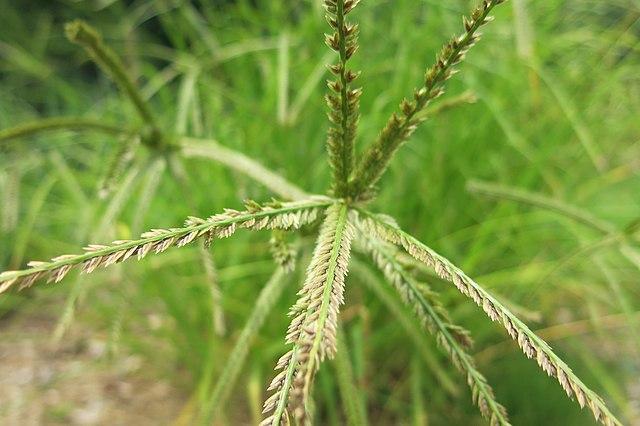 Goosegrass flower heads. | 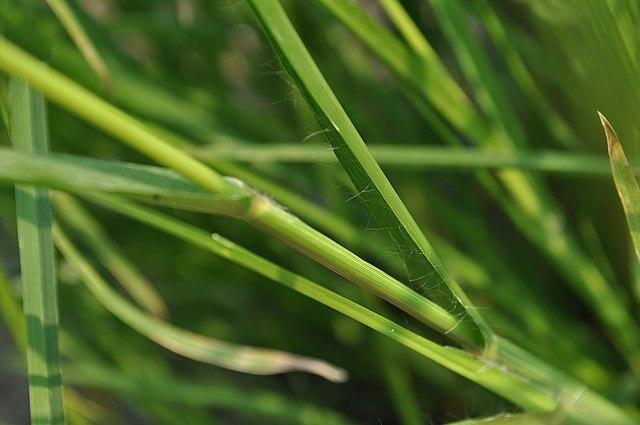 Goosegrass stem and leaves. |
It is called goosegrass because of its unique flower heads with two to ten finger-like threads spread out like a goose’s foot. Goosegrass is a common weed of short mowed grass and other turf areas, including golf greens, athletic fields and fairways.
Goosegrass can be controlled by using pre-emergent chemical herbicides in early spring or late summer. However, if there are only a few goosegrass plants on your lawn, you can mix a cup of salt mixed in a gallon of water and use it to kill the goosegrass.
Goosegrass Quick Facts & Identification
| Scientific Name | Eleusine indica |
| Other Names | Crowfoot grass, Wiregrass, Indian goosegrass, Yard grass |
| Weed Type | Annual |
| Height | 30 to 130 cm |
| Identification | – It has a whitish and flattened stem – Shows a prostrate growth habit – Base of the weed is silver or gray |
| Habitat | Commonly found in areas of heavy wear or compacted soil |
Crabgrass
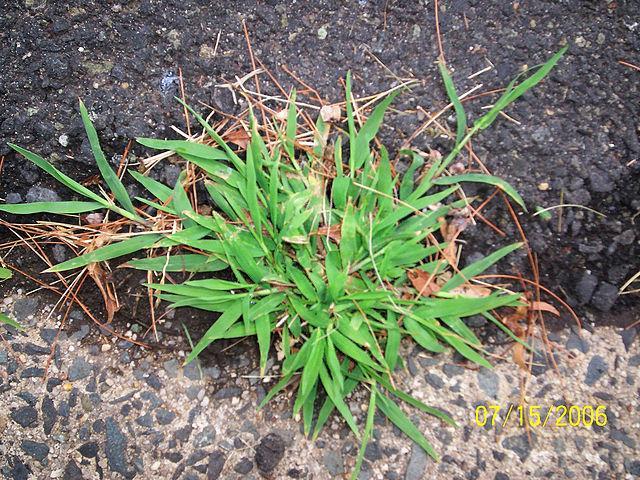 Crabgrass leaves. | 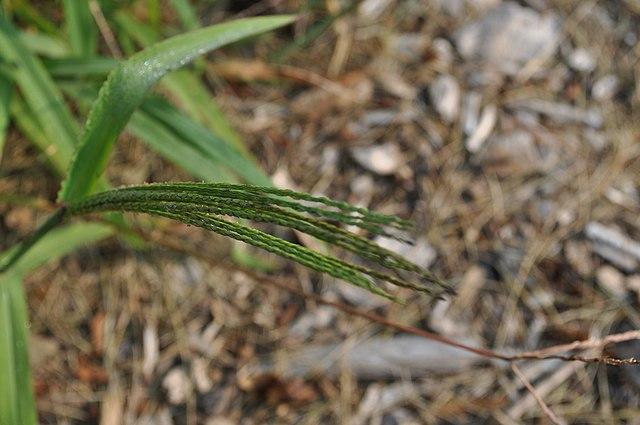 Crabgrass inflorescence. |
An annual summer weed that also has a prostrate growth habit. Ensuring a dense turf and a proper lawn care management plan is the best way to keep these grassy weeds out of your lawn.
It often invades lawns that are seeded late in spring because of the onset of hot weather, frequent watering, and bare soil, perfect conditions for crabgrass growth.
Both preemergence and postemergence herbicides are available to control crabgrass. However, we suggest using cultural control methods to restrict its spread as chemical control methods can also harm desirable plants.
Crabgrass Quick Facts & Identification
| Scientific Name | Genus Digitaria |
| Other Names | Fonio, Finger grass |
| Weed Type | Annual and perennial |
| Height | About 6 inches |
| Identification | – Yellowish green to lime green in appearance – Broad leaves – Seed heads are spiky and finger-like |
| Habitat | Common in dry and heavy clay-loam soil |
Frequently Asked Questions (FAQs)
What weeds look like grass?
Well, there are many. In addition to the species mentioned above, Yellow salsify, Johnson grass, Carpet grass, Path rush, and Wild onion are some other weed species that look like grass.
How can you tell the difference between grass and weeds?
Identifying and locating grassy weeds can be difficult. You can easily miss them unless you know what you are looking for. Nonetheless, look for unusual growth patterns in your lawn to see if any grassy weeds are poking around.
Is there any app for identifying weeds that look like grass?
Here is a weed identification tool from the University of Wisconsin that might be helpful for you.
Sources for Further Reading
- Grassy Weeds. (2022). Retrieved 25 April 2022, from https://hgic.clemson.edu/factsheet/grassy-weeds/
- Controlling Grassy Weeds in Home Lawns — Oklahoma State University Turfgrass Science. (2022). Retrieved 25 April 2022, from http://turf.okstate.edu/pest-management/weeds/controlling-grassy-weeds-in-home-lawns/
- Perennial Grassy Weeds in Lawns – Lawn Talk- University of Illinois Extension. (2022). Retrieved 25 April 2022, from https://web.extension.illinois.edu/lawntalk/weeds/perennial_grassy_weeds_in_lawns.cfm
After reading this guide about common weeds that look like grass make sure to also check out our other articles:
When To Overseed Bermuda Grass: The Best Time And The Dos and Don’ts







